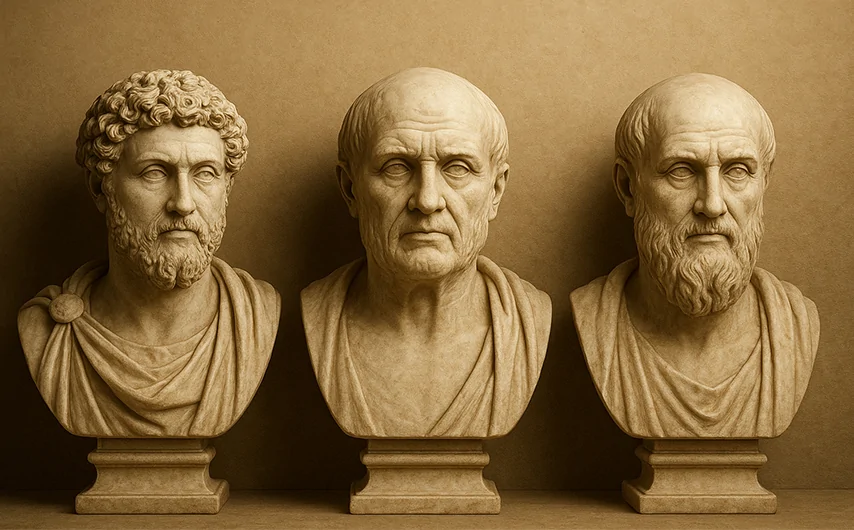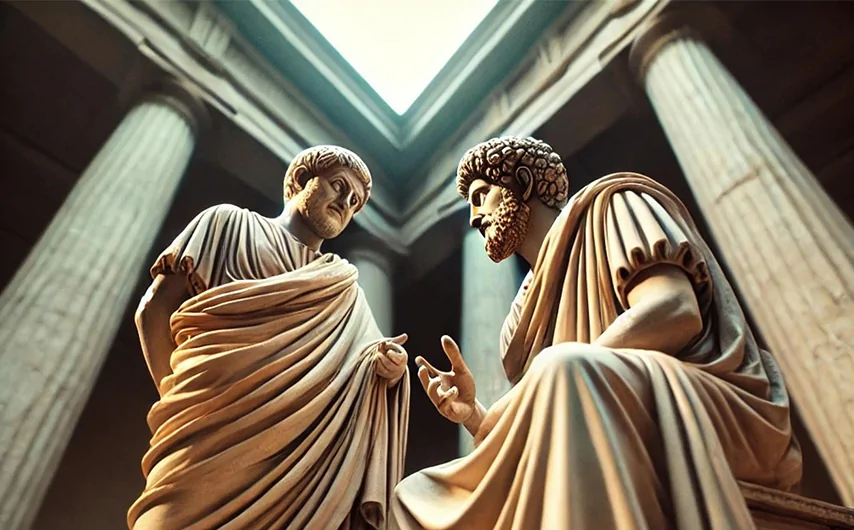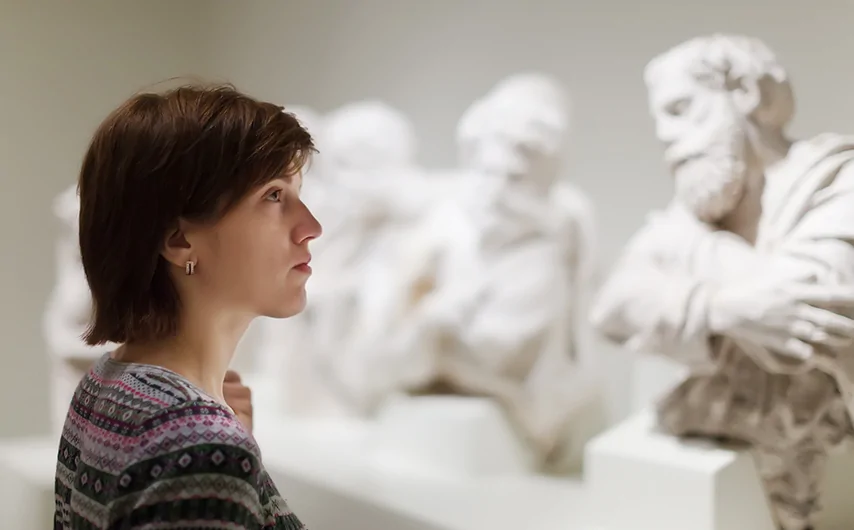
Global crises, wars, the coronavirus pandemic, constant stress and information overload have led to an increase in the number of people with mental health disorders. According to WHO data in 2025, more than a billion people already have psychological problems, most of which are depressive and anxiety disorders.
But is there a way to overcome anxiety, keep one’s composure and, despite everything, avoid falling into depression? Yes — this philosophical current is called Stoicism. This ancient Greek school of philosophy teaches how to find inner balance through the rational regulation of passions and the acceptance of the fact that a person cannot influence many events. Admit it — this is exactly what most modern people lack. Stoicism remains a popular system of thought; over two and a half millennia this current has not only retained its relevance but is experiencing a true renaissance in the 21st century.
In this article we will examine the formation of the Stoic school, the influence of its ideas on psychology and the possibilities for applying ancient wisdom today.
On our website you can take a free anxiety test.
Foundation of the school

Stoicism appeared in the Hellenistic era, when the familiar order of the Greek world was being disrupted by external conquests and numerous internal conflicts. Around 300 BCE, Zeno, a native of Cyprus, founded a new philosophical movement in Athens. Students gathered in a public building on the Athenian Agora — the painted portico Stoa Poikile. The school’s name derives from that location.
Zeno built a system based on three components: logic should serve as an instrument for discovering truth, physics should explain the structure of the cosmos, and ethics should provide guidelines for a righteous life. All three directions were considered inseparable — a virtuous existence is impossible without an understanding of natural laws and the capacity for logical thought.
Zeno formulated a central idea: just as strong columns withstand any weather, so a person should preserve firmness of spirit in the face of life’s trials. He argued that true freedom consists not in changing external circumstances but in one’s own right attitude toward what happens.
The evolution of the doctrine over the centuries

Historians distinguish three stages in the development of the Stoic tradition. Each period enriched the teaching with new ideas and approaches.
Early Stoa: foundations of the school

The 3rd–2nd centuries BCE laid the theoretical foundations of the school. Zeno divided all phenomena into things that depend on a person and things that do not — this idea would become central to Stoicism. According to Zeno, a person must learn self-mastery and manage their passions. Then they will become independent of circumstances, including material and social status. His teaching arrived at the right time, enjoyed enormous success and attracted many followers.
Zeno’s successor was Cleanthes of Assos. He worked as a porter at night so he could attend philosophical lessons during the day. Cleanthes is credited with the saying Ducunt volentem fata, nolentem trahunt — “Fate guides the willing, drags the unwilling.” Cleanthes developed ideas of equanimity and virtue.
Chrysippus of Soli wrote over 700 works and defended the doctrine against critics. Contemporaries said, “If not for Chrysippus, there would be no Stoa.” He argued that emotions are merely false judgments that can be corrected by right thinking. Chrysippus systematized the teaching, strengthened its logical basis and made Stoicism a coherent philosophical system.
The Early Stoa established the foundations of Stoicism:
- Wealth and fame are not true goods. Only virtue is the real good and makes a person happy.
- Fatalism. The world is already ordered and governed by a higher reason, so one should accept the inevitable (illness, death, loss) without suffering.
- A person is not a slave to desires and fears. One can learn to control one’s feelings and emotions. Circumstances are not subject to us, but our attitude toward them is.
Middle Stoa: adaptation for the Romans

In the 2nd–1st centuries BCE Greek Stoicism encountered Roman practicality. Panaetius of Rhodes was the first to see that the harsh demands of the early Stoics were too far removed from real life. Panaetius introduced the notion of those “making progress” — people who move toward virtue in small steps, erring and learning along the way.
Romans always valued public service above private interest. For a Roman it was important to participate in politics, defend the fatherland and care for one’s family. Panaetius accounted for this and softened the teaching on fatalism. Now “living according to nature” came to mean placing such virtuous aspirations above the animal instincts present in every person. Posidonius expanded the philosophy through an interest in science, history and psychology, which brought Stoicism closer to other philosophical trends popular among the Roman elite at the time — Platonism and Aristotelianism.
The Middle Stoa became a “golden” period for Stoicism — the school’s ideas grew more universal and fit well with Roman ideals. Cosmopolitanism and philanthropy became popular and spread with Rome’s expansion. The philosophy and ethics of Stoicism from this period influenced notable figures such as Aristotle, Cicero and Tiberius Gracchus.
Late Stoa: practical wisdom

The 1st–2nd centuries CE mark the period of practical implementation of Stoic ideas. At that time Stoicism became something like a state philosophy of the Roman Empire, followed by both the emperor Marcus Aurelius and the slave Epictetus. Abstract concepts receded into the background and the emphasis shifted to the ability to remain calm and dignified in the face of real life trials. It was in the Late Stoa that Stoicism acquired the practical form that had a profound influence on the development of Christianity and European culture.
Three outstanding Stoics of this period created works that are still read and studied today. Seneca lived for a long time in luxury but wrote about disdain for wealth. Critics called him a hypocrite. Perhaps they were right — but Seneca honestly acknowledged his own moral contradictions. In his treatises and letters he developed the idea of inner calm and liberation from passions.
Epictetus survived slavery and knew the true value of freedom. In his youth his master broke his leg — Epictetus limped for the rest of his life. But this very experience taught him to distinguish between what depends on us and what does not. The master could break his leg, but could not break his spirit. Epictetus emphasized that a person is free if they govern their attitude to events, even if the events themselves lie beyond their control.
Emperor Marcus Aurelius wrote a journal for himself without intending publication. That is why his notes are so sincere — he argues with himself, reproaches himself for weaknesses and reminds himself of life’s transience. Marcus Aurelius applied Stoicism to the life of a ruler of a vast empire, balancing fatalism with the need to make decisions that affected millions of subjects.
Modern adaptation
![]()
Stoicism has experienced several waves of revival since antiquity. Each era found answers in the ancient teaching to the pressing challenges of its time. During the religious wars of the 16th century and even amid the information chaos of the 21st century, the philosophy of the Stoics demonstrates its viability.
Justus Lipsius, a Flemish humanist, rediscovered Stoicism for the European intellectual elite in the 16th century. His work On Constancy (1584) appeared at the height of the religious wars, when Europe was drenched in the blood of Catholic–Protestant conflicts. Lipsius proposed Stoic equanimity as an alternative to religious fanaticism. He adapted ancient texts for a Christian audience, demonstrating the compatibility of Stoic virtues with Christian morality.
Neostoicism in the 17th–18th centuries influenced the Enlightenment. Montaigne quoted Seneca, Descartes studied Epictetus, and Spinoza developed an ethic that resembles Stoic thought. Even revolutionaries found inspiration in the Roman Stoics — the Jacobins saw in Cato the Younger an exemplar of republican virtue.
The 21st century has brought a new wave of interest in Stoicism. The Modern Stoicism movement originated in academic circles but quickly spread beyond them. Donald Robertson, a psychotherapist and author on Stoicism, combined ancient practices with modern cognitive therapy. Massimo Pigliucci, a philosopher at New York University, popularizes Stoicism through books and podcasts.
The digital age has made Stoicism part of popular culture. The annual Stoicon conference draws thousands of participants in different countries. YouTube channels about Stoicism rack up millions of views. Smartphone apps offer daily Stoic reflections and exercises. Social networks are full of quotes from Marcus Aurelius and Epictetus.
Contemporary Stoics adapt ancient principles to solve the problems of post-industrial society. Stoic principles help reduce anxiety and cope with information overload. The dichotomy of control teaches not to worry about likes on social media. Stoic acceptance helps people endure financial and career crises.
Fundamental principles of Stoicism

Stoic philosophy rests on several key ideas that form the foundation of the entire system. These principles are simple to understand but require consistent practice to master. They help a person find inner balance and focus on what truly matters.
Dichotomy of control
Epictetus began his lectures with a simple assertion: “Some things are within our control, others are not.” This idea became the cornerstone of Stoic practice. Understanding the limits of one’s influence frees one from useless worry and directs energy into constructive channels.
Within our control are our thoughts, judgments and actions. We can choose how to react to events, what conclusions to draw from them and how to act in particular situations. This sphere of full control remains inviolate regardless of external circumstances. Even in prison a person retains power over their inner world.
Outside our control lie wealth, fame, health, the opinions of others, natural disasters and political events. We can influence these areas indirectly, but cannot fully control them. A wealthy person can lose their fortune, a celebrity can lose popularity, a healthy person can fall ill. Stoics call such things “preferred indifferents” — it is better to have them than not, but happiness does not depend on them.
Practical application of the dichotomy of control begins with a daily analysis of one’s worries. A student is anxious before an exam — what can they control? The quality of preparation, amount of sleep, nutrition before the exam. What can’t they control? The mood of the examiner, the behavior of other students. Focusing on what can be changed brings calm and increases the effectiveness of actions.
Modern research supports the effectiveness of this approach. People who concentrate on controllable factors suffer less from stress and anxiety. They make more balanced decisions and adapt better to change. The dichotomy of control has become the basis for many psychotherapeutic methods, including cognitive-behavioral therapy.
Virtue as the only good
Stoics held that virtue is the only true good, something that cannot be taken away. External circumstances may change, but the inner core of a person remains inviolable. This radical idea overturned conventional notions of value — wealth, fame and even health became secondary compared to moral excellence.
Ancient philosophers identified four cardinal virtues that form the basis of character:
- Wisdom — the ability to correctly understand the world and make reasoned decisions. The capacity to distinguish what is good, what is bad and what is indifferent to true well-being.
- Justice — the ability to act rightly toward others. This includes honesty, fidelity to obligations and respect for the rights of others.
- Courage — fortitude in the face of difficulties, danger and loss. It manifests not only as physical bravery but as moral firmness in defending principles.
- Temperance — control over desires and emotions. It helps avoid extremes in pleasure, anger, sorrow or joy.
Stoics argued that these virtues are interconnected and complement one another. It is impossible to be truly wise without justice, or courageous without temperance. A virtuous person cultivates all these qualities simultaneously.
Other goods were classified as “preferred things.” Health is preferable to illness, wealth preferable to poverty, but they remain instruments rather than ends. A wealthy person can use money to help others or to corrupt themselves — money is morally neutral in itself. Illness can teach patience and compassion, and health can breed complacency.
True happiness, according to the Stoics, lies in inner virtue. A person who lives according to these principles remains content regardless of external circumstances. Socrates in prison was happier than his judges because he remained faithful to the truth. Epictetus, in slavery, attained more freedom than his masters because he liberated his mind from false notions of the good.
Living in accordance with nature

Stoics believed the universe is governed by a rational principle — the Logos. This divine reason pervades all that exists, and a human being, as a rational creature, contains within them a fragment of cosmic reason. Therefore people should live according to their rational nature.
Living according to nature does not mean returning to a primitive existence. For the Stoics, human nature is the capacity to think and act on principle. Animals follow instincts; humans can analyze situations and make conscious decisions. It is rationality that distinguishes us from the animal world.
Cosmopolitanism was a revolutionary idea in the ancient world, divided into Greeks and barbarians, free people and slaves. Stoics proclaimed that all people possess reason and therefore belong to a single community. Marcus Aurelius wrote, “My city, insofar as I am an Antonine, is Rome; insofar as I am a man, it is the world.” This idea influenced attitudes toward slaves, international politics and human rights.
Acceptance of fate does not imply passivity. Stoics distinguished between acceptance and resignation. Acceptance is acknowledgment of what has already happened without useless resistance. Resignation is a refusal to act where change is still possible. Epictetus compared a person to an actor — the role is written by fate, but the quality of performance depends on us.
Stoicism and modern psychology

Ancient Stoic philosophy has unexpectedly resonated with modern science. Ideas developed two thousand years ago by Epictetus and Marcus Aurelius are today supported by research and clinical practice. Stoicism has become a bridge between ancient wisdom and 21st-century scientific psychology.
Influence on cognitive-behavioral therapy
The Stoic idea that thoughts shape emotions and behavior became a foundation of modern psychotherapy. Epictetus asserted, “People are disturbed not by things, but by the views they take of them.” This concept anticipated scientific psychology by two millennia and today underlies cognitive-behavioral therapy (CBT).
Albert Ellis openly acknowledged the influence of Stoic philosophy on his rational-emotive therapy. In the 1950s–60s he developed the ABC model: an activating event (A) leads to beliefs (B),which produce emotional and behavioral consequences (C). Ellis often quoted Epictetus and taught patients to identify irrational beliefs and replace them with more realistic appraisals of situations.
Viktor Frankl, in concentration camps, experienced firsthand the truth of Stoic principles. His logotherapy is built on the idea that a person can find meaning in any circumstances, even the most extreme. Frankl wrote, “Everything can be taken from a man but one thing: the last of the human freedoms — to choose one’s attitude in any given set of circumstances.” This thought directly echoes the teaching of the dichotomy of control.
Aaron Beck developed cognitive therapy for depression based on identifying and changing negative automatic thoughts. His approach to cognitive distortions — catastrophizing, black-and-white thinking, personalization — closely resembles Stoic exercises in analyzing judgments. Beck did not directly cite ancient philosophers, but he used similar techniques for working with thought patterns.
Scientific research
Modern studies confirm the effectiveness of Stoic principles in addressing psychological problems. Hofmann and colleagues’ meta-analysis showed that cognitive-behavioral therapy significantly reduces symptoms of anxiety and depression in most patients.
Robertson and colleagues studied the impact of a week-long course of Stoic practices on psychological well-being. Participants who applied Stoic techniques daily showed a significant reduction in stress levels and an increase in life satisfaction compared with a control group.
The practice of keeping a journal, actively used by Marcus Aurelius, has proven to be a powerful tool for developing resilience. Pennebaker and Evans found that regular written expression of thoughts and feelings strengthens the immune system, improves mood and helps cope with traumatic events.
Stoic techniques show striking parallels with meditative practices. Studies have found that regular meditation increases gray matter density in areas associated with learning and memory. Hölzel and colleagues documented these changes after an eight-week meditation program.
Of particular interest are studies of neuroplasticity — the brain’s ability to change in response to experience. Davidson and Lutz demonstrated that regular practices of self-reflection and emotional regulation, characteristic of Stoicism, literally rewire neural connections. Activity in the prefrontal cortex, responsible for impulse control, increases while reactivity of the amygdala, associated with stress responses, decreases.
Practical applications of Stoicism

Stoic principles are actively used across many areas of life — from managing large companies to everyday interactions with loved ones.
In the professional sphere
Stoic ideas work particularly effectively here. Take the dichotomy of control. In a project, a manager can influence planning, team motivation and resource allocation. But client demands or competitors’ actions are beyond their control. Focusing on what you can actually influence saves nerves and improves performance.
Main Stoic approaches at work:
- Viewing criticism as a source of growth rather than a reason for offense.
- Leading by serving the team rather than by demonstrating power.
- Maintaining clear thinking in crisis moments.
- Focusing on the process rather than on results that are not entirely up to us.
Such an approach fosters a healthy atmosphere in the team and makes work more meaningful.
In relationships
Stoicism suggests building relationships on a realistic basis. We cannot remake other people, but we can change our attitude toward them.
Epictetus advised occasionally to imagine, in the mind, the loss of a loved one. It sounds grim, but in practice this technique increases gratitude for every day spent together. Parents stop scolding children over trifles; spouses appreciate time together more.
Principles of Stoic relationships:
- Accept your partner as they are, without trying to remake them.
- Work on your own reactions instead of making demands of others.
- Practice daily gratitude for the positive qualities of loved ones.
- Resolve conflicts by seeking common values rather than arguing.
Relationships become stronger when built on mutual respect and appreciation of each partner’s positive qualities.
In personal finance and consumption
A modern Stoic earns for a comfortable life and to help others, but does not make money an end in itself. He distinguishes real needs from imposed desires, avoids impulsive spending and dependency on credit.
Stress management and health
When stressed, a Stoic first asks: “What here depends on me?” A clear separation between what depends on you and what does not immediately reduces anxiety and channels energy into constructive action.
Seneca reviewed each day every evening — what went well, where mistakes were made, how to act better tomorrow. Such reflection strengthens emotional resilience and helps extract lessons even from negative experiences.
Techniques and exercises: implementing Stoicism in everyday life
Stoic philosophy becomes an effective tool only through regular practice. The ancient Stoics developed concrete exercises that can be adapted to the modern pace of life. It’s best to start with one or two techniques and gradually expand your arsenal.
Morning reflection: mindset and readiness for challenges
Marcus Aurelius began each day by reflecting on upcoming challenges. A modern version of this practice takes just 5–10 minutes in the morning.
Sit quietly and mentally run through your plans for the day. Think about which difficulties might arise — tough negotiations, traffic jams, a conflict with a colleague. Imagine how you will respond to each situation calmly and constructively. Remind yourself: external events cannot ruin your day; only your reaction to them matters.
This technique acts like a mental inoculation: when an unpleasant event actually occurs, you are already prepared for it morally.
Evening review: analysis of actions, lessons, gratitude
Seneca considered the evening review the principal tool of self-improvement. Each evening he analyzed the day as an impartial judge.
Epictetus advised occasionally to imagine, in the mind, the loss of a loved one. It sounds grim, but in practice this technique increases gratitude for every day spent together. Parents stop scolding children over trifles; spouses appreciate time together more.
Before bed, set aside 10–15 minutes to analyze the day:
- What went well today and why.
- Where you acted suboptimally and how you could have done better.
- What you can be grateful for — fate, people, circumstances.
- What lesson can be drawn from today’s experience.
You can also keep a journal — putting things in writing strengthens the effect of the exercise.
Meditation
Stoics considered the four cardinal virtues the foundation of a happy life. Regular reflection on them helps to shape character.
Choose one virtue for the week and reflect on it every day:
- Wisdom. How to demonstrate sound judgment, curiosity and openness to new experience?
- Justice. How to be honest, help others and fulfill obligations?
- Courage. Where must you show fortitude, defend principles and overcome fear?
- Temperance. How to avoid excesses, control impulses and maintain balance?
View from above: diminishing the significance of problems
Marcus Aurelius often used the technique of expanding perspective. When a problem seems enormous, it helps to view it from a great distance.
Imagine how your current difficulty will look in a year, in ten years. Mentally rise above the city, the country, the planet. Look at Earth from space — a small blue ball in an infinite universe. From that perspective most everyday problems lose much of their drama.
This is not devaluing your feelings but a way to see them in the proper scale.
Negative visualization
Stoics regularly imagined the loss of what they held dear — health, loved ones, possessions. The goal is not to become a pessimist but to appreciate the present more.
Once a week, imagine losing something important to you. How would you cope? What really matters in life and what is secondary? For what are you grateful right now?
Paradoxically, reflecting on losses intensifies joy in what you have and makes a person more resilient to fate’s blows.
Where to start
Beginners should choose one exercise and practice it for two weeks until it becomes a habit. It’s best to start with the evening review — it requires no extra time and immediately yields noticeable results.
The second step is to add the morning reflection. These two techniques create a full cycle of mindful living. Introduce the other exercises gradually once the basic practices feel natural.
On our website you can take the Five-Facet Mindfulness Questionnaire (FFMQ) for free.
Criticism and limitations of Stoicism
Stoicism, like any philosophical system, has its shortcomings. Over more than two thousand years it has faced serious criticism — from accusations of emotional coldness to reproaches of social passivity.
Accusations of coldness and passivity
The most common complaint against Stoicism is that it turns a person into an unfeeling robot. Critics argue that stoic suppression of emotions leads to detachment from life and an inability to experience deep feelings.
Feminist theorists are particularly harsh in their criticism of the Stoic model of behavior. They see in it a typically male strategy of avoiding vulnerability through rational control. Psychologist Carol Gilligan points out that Stoic suppression of emotions can hinder the development of empathy and the capacity to care for others.
Cultural scholars note the Western, predominantly elitist nature of Stoicism. A philosophy developed by educated men of a slaveholding society may poorly fit other social groups. Calls to accept injustice can sound cynical to those who fight real oppression.
Social activists criticize the Stoic focus on internal change as a form of political passivity. If everyone calmly accepts injustice, who will fight for social change?
Risks of misunderstanding
The popularization of Stoicism has led to many distorted interpretations that can do more harm than good.
Modern pseudo-Stoics often reduce the philosophy to simplistic positive thinking: “Everything is for the best,” “Don’t be sad, be strong,” “Think positive” — such injunctions devalue people’s real suffering.
True Stoicism does not demand pretending that bad events are good. It teaches a realistic assessment of situations and finding constructive ways to cope. Grief over the loss of a loved one is a natural reaction that should not be suppressed. A Stoic allows oneself to grieve but does not let grief destroy one’s life.
Many people interpret Stoicism as total suppression of feelings. This is a dangerous misconception that can lead to psychological problems.
Stoics did not call for becoming unfeeling. They distinguished primary emotions (natural reactions) from secondary ones (our judgments about those reactions). It is normal to feel frightened after a minor car accident. But refusing to drive afterwards would be a choice we make.
Modern psychology confirms: suppression of emotions is harmful to mental and physical health. Stoic practice aims at consciously experiencing feelings without losing control over behavior.
The popularity of Stoicism has spawned an industry of quick fixes. “Stoicism in 30 days” books, “Stoic Millionaire” courses, smartphone apps — much of this has little to do with serious philosophical practice.
Marketing Stoicism promises easy results without deep inner work. It turns a complex philosophical system into a set of productivity life-hacks. Such an approach may produce short-term effects but does not create lasting character change.
True Stoicism requires years of practice, honest self-reflection and readiness to revise one’s beliefs. It is a path of gradual inner growth, not a quick hack for life success.
Conclusion
Stoicism shows remarkable parallels with various religious and philosophical traditions. Buddhist teachings on non-attachment, the Daoist principle of non-action, the Christian idea of humility — all these concepts resonate with Stoic principles of acceptance and inner peace.
The universality of Stoic philosophy is explained by its appeal to fundamental questions of human existence. How to live with dignity in an unpredictable world? How to preserve inner balance despite losses and difficulties? How to find meaning in suffering? These questions remain relevant regardless of era or culture.
The modern world with its life “on display” and endless race for success is especially in need of Stoic wisdom. Techniques for managing attention, regulating emotions and finding meaning, developed two thousand years ago, prove to be strikingly modern.
Stoicism is not a panacea for all problems, but it offers time-tested tools for creating a more meaningful and tranquil life. In an age when external circumstances change at the speed of light, Stoic focus on what truly depends on us becomes not just a philosophical idea but a practical necessity.
Bonus: 10 best Stoic quotes
A bonus for those who read the article to the end — the most striking sayings of the great Stoics that have not lost their relevance in two thousand years.
Epictetus:
- “People are not disturbed by events, but by their judgments about events.”
- “Do not demand that things happen as you wish; wish them to happen as they do, and your life will flow smoothly.”
- “Wealth consists not in having great possessions, but in having few wants.”
Marcus Aurelius:
- “You have power over your mind — not outside events. Realize this, and you will find strength.”
- “The best revenge is not to be like your enemy.”
- “What good is a candle? It does not light the wind, yet it burns steadily amid it.”
Seneca:
- “We suffer more often in imagination than in reality.”
- “It is not the man who has too little, but the man who craves more, that is poor.”
- “Each new day is an opportunity to change your life.”
- “Time is the only thing which truly belongs to us.”
These words were written in a completely different era, yet they remain relevant. Perhaps because human nature remains unchanged, and wisdom does not depend on technologies or social arrangements.